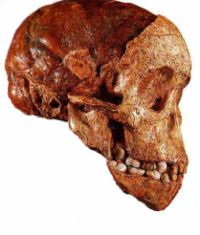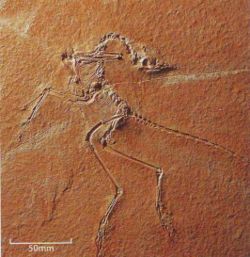Fossilization (palaeontology)
Fossilization is the process that creates a fossil. The word "fossil" is derived from the Latin fossilis, something dug up.[1]
During the Middle Ages, the term "fossil" was used for any sample recovered from the earth, including rocks and minerals.[1] Today, fossils are recognised as a record of ancient life. They can be actual remnants of an organism, or evidence of their behaviour.[1]
Understanding the process of fossilization, and the different means through which it can occur, is crucial to comprehending the fossils being studied. The fossils we find today are not a representative sample of past life. Certain organisms, and particular elements of those organisms, are more likely to be preserved than others, as well as certain environments are more suitable for fossilization than others.
Taphonomy is the study of what has happened to an organism from the moment of death until it is found as a fossil.[2] Exploring the process of fossilization from a taphonomic perspective allows us to place individual fossils into a wider context. Consequently, we can reconstruct not only their skeletal morphology, but hopefully their behaviour, life history and palaeoenvironment.

Overview
Any plant or animal needs to pass through a number of stages in order to become a fossil.[4]
| Stage | Definition |
|---|---|
| Death | Generally, this is the first stage in fossilization. However, death can also occur as a result of burial |
| Biostratinomic processes | Processes such as reorientation, disarticulation, fragmentation, and corrosion, which modify the remains. Not desirable as information is lost. |
| Deposition | Burial of the remains in sediment, where they are less likely to be disturbed. |
| Diagenetic processes | Chemical / physical changes e.g. permineralization. Necessary for fossilization. |
First, the organism must become deposited in sediment. Between the time of death and burial, biostratinomic processes may alter the remains. Before burial, an organic skeleton is normally subject to reorientation, disarticulation, fragmentation, and corrosion. Once it is buried, it may begin to undergo diagenetic processes. Diagenesis is simply any change, chemical or physical, which occurs in an organism after burial.[4] Such changes are necessary for preservation because organic matter will not survive for long before it is decomposed. A typical diagenetic process is mineralization, which can occur with various minerals such as pyrite, phosphate or silica.[4]
Fossilization is not a process that only occurred millions of years ago. It has also occurred in the recent past, simply because the same geological processes that happened in the past are also taking place now. This is called the Principle of Uniformitarianism.[5] Anna Behrensmeyer reported bones in all stages of fossilization, from organic to completely mineralised, in the Amboseli Basin of East Africa.[6] Bones are dated from the Holocene to the Pleistocene, negating the claim made by some that no instances of fossilization are apparent today.
“Post-mortem modification is a virtually unavoidable fact of fossilization”.[7] Older fossils are more likely to have been modified by diagenetic processes, and thus, to be a less accurate copy of the original.[7] Analysis of modes of fossilization in an assemblage can reveal whether that assemblage represents input from more than one source.[8]
Styles of fossilization
There are five general types of fossilization: carbonised soft tissue, diagenetically mineralised three-dimensional tissue, tissue outlines, carbonised refractory tissue, and originally mineralised tissue i.e. shell and bone.[7] The mineral replacement of shell or bone is called petrification, because it turns organic material into stone.[5] Trace fossils are not remnants of an organism itself, but some record of its behaviour. Tracks, burrows, coprolites (fossil faeces), and stone tools are all examples of trace fossils. An organism can leave a mould behind when it decays, preserving surface detail in the surrounding sediment. If the mould later fills with sediment, an replica of the organism is created, called a cast. A cast does not preserve the internal or cellular structure of the original organism, but only its surface detail.[1] The term cast is also used to indicate three-dimensional copies of a fossil, made out of plaster and resin. These casts are useful for teaching purposes, or when the original fossil is fragile or damaged. However, these laboratory casts are created in a similar way to a real cast forming in nature, by using a mould. The endocranial cast of the Taung child was formed naturally by the accumulation of lime inside the skull, and preseves the sutures of the brain on its surface.

Bones have a high porosity and are filled with marrow. If bones become buried when an animal dies, ground water can permeate. Minerals such as calcium carbonate and silica precipitate out of solution and solidify the organic material, accurately preserving the internal cellular structure. This is called permineralization, and has occurred in most older fossils.[1] In permineralization, the cell pores are packed with minerals, while the walls remain highly organic.[7] Replacement happens when minerals replace the organic matter completely. When a fossil is petrified, both the cell walls and voids are mineralised.[7] Around 20 different minerals have been found to replace fossils. Chalcedony, pyrite and iron oxide are common in replacement.[1]
Conditions for preservation
Fossils represent a very small proportion of all the organisms which have ever lived. This is because fossils only form under specific conditions. Decomposition is a requirement for environments to function, and so fossilization represents a deviation from this natural process.[1] Destructive agents which aid decomposition include predators and scavengers, transport by wind and water, weathering by changes in temperature, wind, rain and chemicals, and decay by microbes, insects and roots.[2] Various agents can be responsible for the preservation of organisms. Commonly, sediments bury the remains and keep them from being disturbed during the process of fossilization. More unusual agents include lava or volcanic ash, and severe cold or aridity.[2] Temperatures below 4°C inhibit bacterial activity and thus, decay of organic matter.[7]
Generally, the following circumstances are favourable for fossilization. The organism should be rapidly buried to avoid damage by scavengers or weathering agents like water, wind and fluctuations in temperatures.[5] Fossils are most common in fluvial sediments, and rare in soils.[2] The remains require little or no disturbance during the fossilization process. The organism should be buried in anaerobic conditions, because oxygen encourages the presence of bacteria which decompose organic material.[5] Examples of anaerobic environments include wet areas like swamps and floodplains. However, decay can occur under anoxic conditions, for example by bacterial sulfate reduction.[10] Anoxia also creates reducing conditions, forming reactive ionic species. This encourages mineral precipitation.[10] Containing some hard parts increases the likelihood that an organism will be preserved, but it is not necessary for fossilization.[11] Although multicellular life was already diversifying well before the Cambrian period, we do not have an extensive record of these pre-Cambrian life forms.[5] It was only during the Cambrian Explosion of life that many forms began simultaneously covering themselves with a hard exterior. This hard surface developed as protection against predation, but also happened to be conducive to fossilization.[5]

Because of the specific conditions needed for a fossil to be created, organisms that do not live in environments favourable to preservation are likely never to appear in the fossil record. Small, gracile animals are normally too delicate to withstand the ravages of time, as are animals living in a high-acidic environment like a tropical forest.[13]High-energy environments have high rates of erosion and low rates of sedimentation, which would not allow for organisms to be buried rapidly, and lie undisturbed. Most depositional environments are mari
- ↑ 1.0 1.1 1.2 1.3 1.4 1.5 1.6 MacRae, C.S. 1999. Life Etched in Stone: Fossils of South Africa. The Geological Society of South Africa, Johannesburg.
- ↑ 2.0 2.1 2.2 2.3 Shipman, P. 1981. Life History of a Fossil: An Introduction to Taphonomy and Paleoecology. Harvard University Press, England.
- ↑ Image source: Terence McCarthy and Bruce Rubidge, The Story of Earth & Life: A Southern African Perspective on a 4.6-billion-year Journey (2006). Struik Publishers, Cape Town. ISBN 1770071482
- ↑ 4.0 4.1 4.2 Brett, C.E. & Baird, G.C. 1986. Comparative Taphonomy: A Key to Paleoenvironmental Interpretation Based on Fossil Preservation. PALAIOS 1(3): 207-227.
- ↑ 5.0 5.1 5.2 5.3 5.4 5.5 McCarthy, T. & Rubidge, B. 2005. The Story of Earth and Life: A southern African perspective on a 4.6-billion-year journey. Struik Publishers, Cape Town.
- ↑ Behrensmeyer, A.K. 1991. Vertebrate Paleoecology in a Recent East African Ecosystem. In: Gray, J., Boucot, A.J. & Berry, W.B.N. (eds.), Communities of the Past, Stroudsburg: Hutchinson Ross Publishing Co.
- ↑ 7.0 7.1 7.2 7.3 7.4 7.5 Allison, P.A. & Briggs, D.E.G. 1991. Taphonomy: Releasing the Data Locked in the Fossil Record. Plenum Press, New York.
- ↑ Henderson, P., Pickford, M. & Williams, C.T. 1987. A geochemical study of rocks and spring waters at Kanam and Kanjera, Kenya, and the implications concerning element mobility and uptake. Journal of African Earth Sciences 6: 221-227.
- ↑ Image source: Terence McCarthy and Bruce Rubidge, The Story of Earth & Life: A Southern African Perspective on a 4.6-billion-year Journey (2006). Struik Publishers, Cape Town. ISBN 1770071482
- ↑ 10.0 10.1 Allison, P.A. 1988. Konservat-Lagerstätten: cause and classification. Paleobiology 14: 331-334.
- ↑ Martin, R.E. 1999. Taphonomy: A Process Approach. Cambridge University Press.
- ↑ Image source: Terence McCarthy and Bruce Rubidge, The Story of Earth & Life: A Southern African Perspective on a 4.6-billion-year Journey (2006). Struik Publishers, Cape Town. ISBN 1770071482
- ↑ DiSilvestro, D.L. 1997. In Quest of the Origin of Birds. BioScience 47(8): 481-485.
